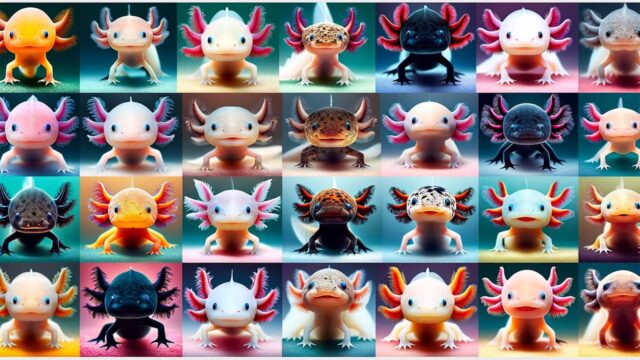
Axolotls, scientifically known as Ambystoma mexicanum, have captivated biologists and pet enthusiasts alike with their extraordinary regenerative abilities and endearing appearance. Originating from Mexico, these amphibians have garnered attention not just for their scientific significance but also for the types of axolotls and their color morphs, making them popular in the exotic pet trade.
This article aims to explore the diverse world of axolotl varieties, shedding light on different axolotl types, colors, unique characteristics, and care requirements.
Table of Contents
The Biology of Axolotl
Axolotls are a type of salamander, but unlike their terrestrial cousins, they exhibit a trait called neoteny. This means they retain their larval features, like gills and a dorsal fin, throughout their life, foregoing the metamorphosis that would turn them into land-dwelling creatures. This unique adaptation has piqued the interest of scientists and hobbyists alike, as it gives axolotls a distinctive, almost whimsical appearance.
Different Types of Axolotls / Color Morphs
The basic color morphs are quite common and popular color options. Apart from the wild ones, the four major mutant morphs of axolotls would fall into this classification. The common mutant morphs are:
- Leucistic – Pale white or pinkish
- Albino – White or golden
- Axanthic – Gray or silver
- Melanoid – Solid black or dark gray
Wild Type Axolotl
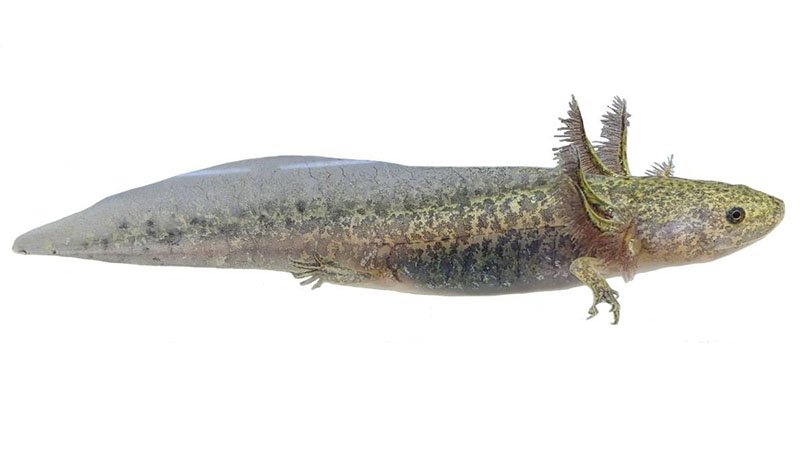
The Wild Type Axolotl, reflecting its natural habitat, boasts a dark, mottled brown color with green, tan, or olive shades, providing excellent camouflage. It’s known for shiny gold speckles, called iridophore pigments, and distinct dark eyes with a gold ring around the pupil. These features distinguish it from other axolotl types.
The external gills of axolotl usually match the body’s dark color, with red or pink tips indicating healthy blood flow. This type can vary slightly in color, often darkening with age, and is characterized by the presence of shiny pigments, unlike the melanoid axolotls. The Wild Type vividly represents the axolotl’s natural beauty in the wild.
Leucistic Axolotl
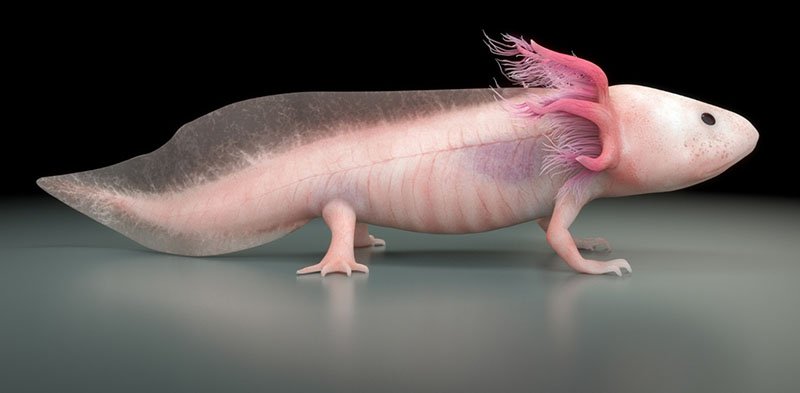
Leucistic Axolotls are unique and eye-catching with their white or pale pink skin, caused by a condition called leucism that reduces pigmentation. Unlike albino axolotls, they have distinctive black or dark-navy eyes. Their gills are often bright red or pink, standing out against their almost transparent skin.
These axolotls may have a few dark spots on their head and back, showing they’re not albinos. Sometimes, they develop freckles, which can be influenced by where they live and their genes. Each Leucistic Axolotl is special, with its pattern of spots or freckles adding charm and individuality.
Melanoid Axolotl
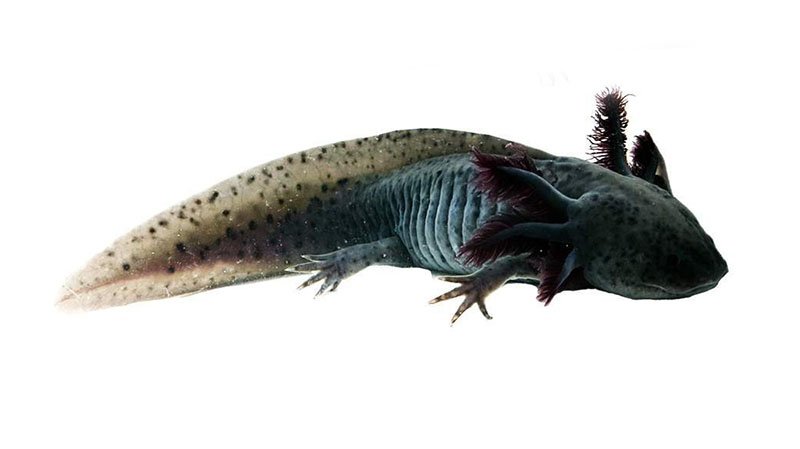
Melanoid Axolotls (also known as Black Axolotls) are a special type of axolotl known for their dark and even coloring. They’re different from other types of axolotls because they don’t have iridophores, the cells that make shiny pigments. This means Melanoid Axolotls have a matte look and are usually a solid black or very dark gray without any shiny or speckled patterns. Their eyes are dark too, missing the shiny gold ring found in Wild Type axolotls. Even their gills are dark, blending in with the rest of their body and looking less bright than other types.
When trying to tell if an axolotl is a Melanoid, the key is to look at its eyes. Unlike other axolotl types, Melanoid Axolotls don’t have a shiny ring around their pupils. They have many melanophores, cells that create dark pigment, making them appear black all over.
Albino Axolotl
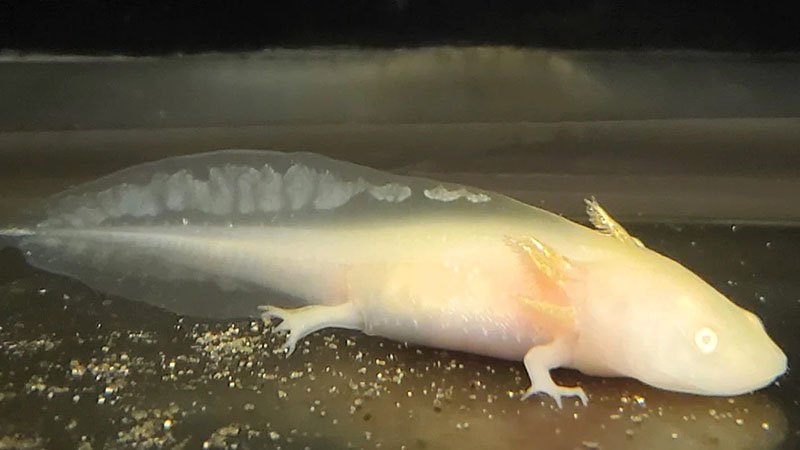
Albino Axolotls are a fascinating type of axolotl known for their lack of melanophores, the cells responsible for dark pigments. This unique trait means they don’t have the typical dark coloring seen in other axolotls. Instead, Albino Axolotls come in a variety of lighter shades, and one of the most common is the golden albino. These golden albinos have a captivating yellow or gold appearance, resulting from the normal migration of pigment cells without dark melanophores. This gives them a bright and distinctive look, different from the usual axolotl colors.
There are several types of albino axolotls, each with its own special appearance. Some of the subtypes are the golden albino, with a yellowish tint, and the white albino, which is paler.
Golden Albino Axolotl
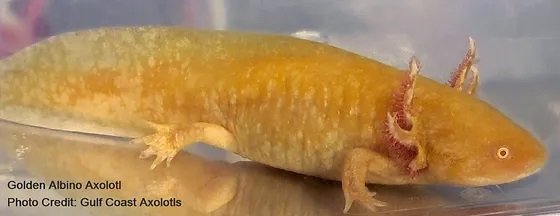
The Golden Albino Axolotl is a unique variety with a vibrant golden-yellow to light tan color, resulting from a combination of yellow pigments and the absence of darker melanophores due to albinism. These axolotls have distinctive clear or red eyes, lacking pigment, allowing the retina’s blood vessels to be visible. Their gills often mirror their body color, showcasing golden or pink hues with brighter tips. As they age, Golden Albinos might become a slightly less intense yellow, and some may have shiny white patches due to heavy iridophore pigmentation, adding to their unique and captivating appearance.
White Albino Axolotl
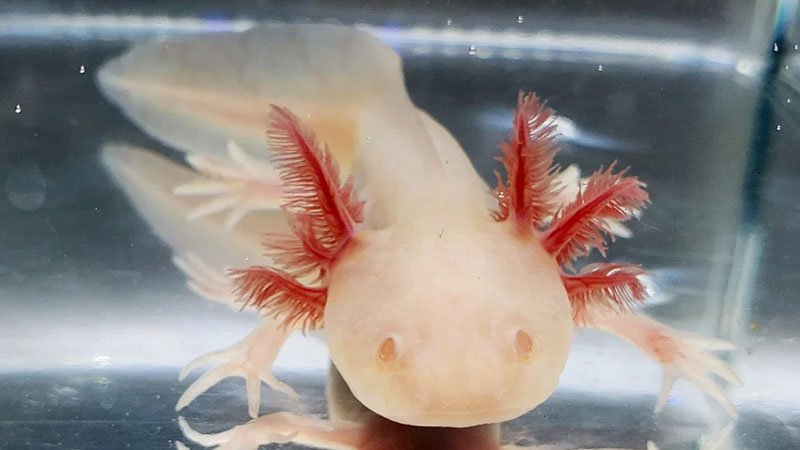
The White Albino Axolotl is a distinct and enchanting type of axolotl, primarily white or very pale pink due to albinism. This genetic condition results in the absence of melanin, the pigment that usually gives color to the skin. Their most striking feature is their eyes, which are typically red or clear, appearing so because the lack of pigment in the iris reveals the blood vessels in the retina. The gills of White Albino Axolotls often match their pale body color and have bright red or pink filaments, which are so vivid due to the blood vessels showing through their translucent skin.
White Albinos are unique not just in appearance but also genetically, being homozygous for “d” and “a” (d/d and a/a). Their gills can have iridophores, and shiny pigment cells, adding a subtle sheen. Unlike leucistic axolotls, they completely lack color pigments across their body, which makes their gills appear pink as the clear skin allows blood flow to be visible. There are variations within White Albinos, with the axanthic type lacking not just black melanophores but also yellow xanthophores and shiny iridophores, resulting in a more uniform pale appearance. The genetic intricacies contribute to the variety within this fascinating albino group.
Axanthic Axolotl
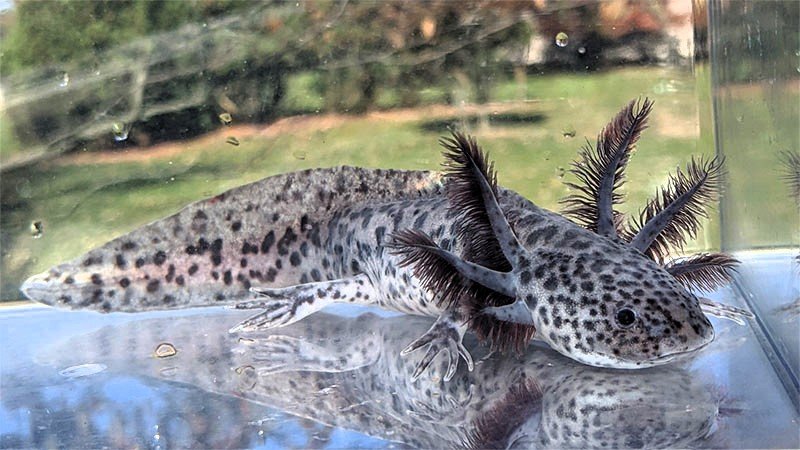
The Axanthic Axolotl is a unique type of axolotl, known for its distinct lack of certain pigment cells. This variety has normal pigment cell migration but is genetically distinct, being homozygous for both the albino gene (a/a) and the axanthic gene (ax/ax). This genetic makeup means that the Axanthic Axolotl lacks melanophores (black pigment cells), xanthophores (yellow and reddish pigment cells), and iridophores (shiny pigment cells). As a result, these axolotls have an almost white appearance, making them stand out among other types.
One interesting aspect of the Axanthic Axolotl is that it tends to become yellowish as it ages. This change in color is due to the accumulation of riboflavins, a natural compound found in their diet. Despite starting life almost white, the diet-induced coloration gives older Axanthic Axolotls a yellow hue, adding to their unique appearance. This color transformation over time is a fascinating characteristic of the Axanthic Axolotl, illustrating how genetics and diet can interact to affect the appearance of these captivating creatures.
Copper Axolotl
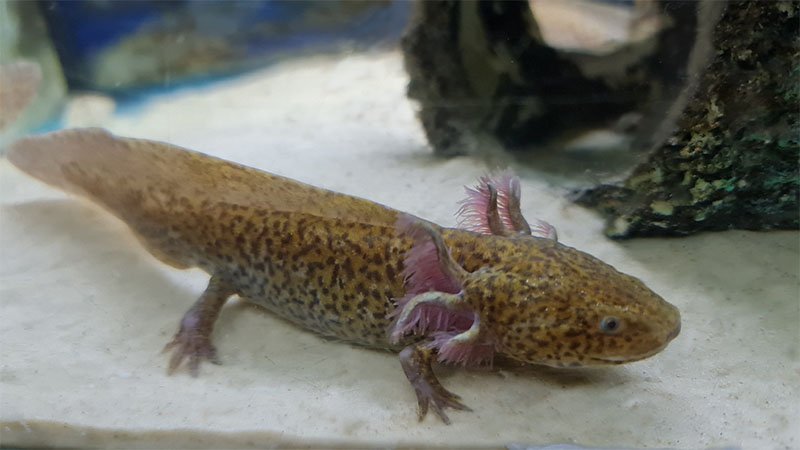
The Copper Axolotl (aka Olive Axolotl) is a special and visually stunning type of axolotl, celebrated for its distinct copper or light brownish-orange coloring. This unique coloration is a result of a specific genetic mutation affecting their pigmentation, placing them in the category of albinism.
Copper Axolotls typically have red-tinted eyes and are known to lay white eggs. Their colors can vary from pale to more intense shades of copper, adding to their striking appearance. The gills of these axolotls usually match or are slightly lighter than their body color, often adorned with a pinkish hue due to visible blood vessels, adding to their aesthetic appeal.
Copper Axolotls are particularly popular in some countries, like Germany and Australia, but are less common or unavailable in others, such as Canada. Despite their popularity, the exact genetic details of the copper variety are not widely understood, making breeding for this specific type a challenge.
These axolotls are characterized by their light brown, pinkish color with darker brown spots and lack any black pigments, known as melanophores. Their distinctive coloring and rarity make Copper Axolotls a prized and intriguing variety for axolotl enthusiasts and breeders alike.
GFP Axolotl
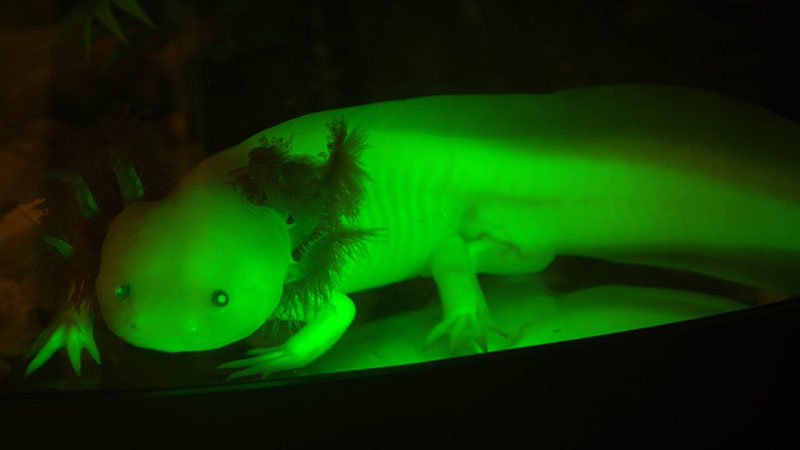
GFP Axolotls are a unique type of axolotl, where GFP stands for Green Fluorescent Protein. This trait was initially introduced in a laboratory setting for research purposes, specifically in studies related to cancer and regeneration. The GFP gene is a recessive trait, meaning it can be passed down through generations and bred into any axolotl morph, be it wild type, leucistic, albino, or melanoid.
The most notable characteristic of GFP Axolotls is their ability to glow a bright green color under ultraviolet (UV) or blue light. This fluorescence doesn’t typically alter their base coloration; GFP Axolotls look similar to their non-GFP counterparts under normal lighting. Their eyes and gills align with their base morph’s characteristics, but the eyes often have an emerald green pupil, and the gills may show some level of fluorescence under specific lighting.
GFP Axolotls are considered a special morph due to this genetic modification. The GFP protein, originally derived from jellyfish, is responsible for their vibrant green glow in UV or black-lighting. It’s important to note that the intensity of the glow can vary based on the axolotl’s pigment; the less pigment they have, the brighter they will glow. The GFP trait doesn’t create a new morph; it’s simply an added feature to existing axolotl varieties. For instance, a GFP leucistic axolotl or a GFP wild type can be obtained from breeders, both glowing beautifully in the dark.
Unique and Rare Varieties of Axolotls
Certain varieties capture attention with their rarity and unique traits in the diverse world of axolotls. These unique and rare axolotl varieties, with their distinct colors and patterns, showcase the incredible diversity of this species. Let’s explore these extraordinary and less common axolotls, each with its own captivating allure.
Chimera Axolotl
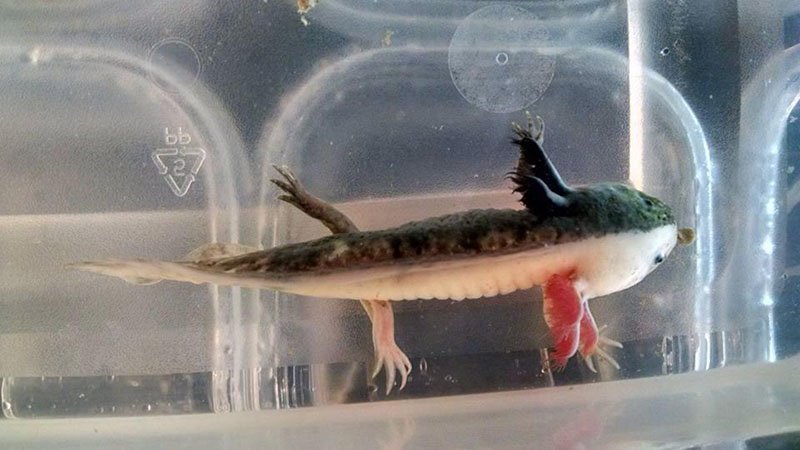
The Chimera Axolotl is one of nature’s most fascinating and rare wonders, a living tapestry of genetic artistry. Born from an extraordinary event during development, the Chimera Axolotl embodies a striking bilateral symmetry in coloration. Imagine seeing an axolotl with one side of its body starkly different in color from the other – like a canvas split down the middle. One side might mirror the snowy hues of a leucistic morph, while the other echoes the deep shades of a melanoid morph. This remarkable pattern occurs when two eggs carrying different genetic information fuse together during embryonic development. The result is an axolotl that literally lives a double life in terms of coloration, with each side reflecting the characteristics of the original egg it came from.
Despite their enchanting appearance, Chimera Axolotls are not a creation of deliberate breeding; they are a rare gift of chance, a serendipitous twist in their developmental journey. The likelihood of an axolotl being a chimera and surviving is incredibly slim, almost a whisper in the vast chorus of genetic possibilities.
Mosaic Axolotl

Mosaic Axolotls are nature’s own masterpieces, embodying a blend of colors and patterns that make each one uniquely beautiful. This stunning variety is the result of genetic mosaicism or chimerism, where the axolotl is composed of cells with different genetic makeups. This fascinating phenomenon can happen naturally or be induced in a laboratory.
Also Read: How to Identify a Mosaic Axolotl
Mosaic Axolotls don’t have a uniform color like other axolotl morphs. Instead, their bodies are adorned with a mix of colors and patterns, similar to the tiles in a mosaic artwork. You might see patches of black, white, gold, and other colors scattered across their body in an irregular and random pattern. This pattern is unique to each individual and can include a variety of spots, patches, and other markings. Their eyes often mirror the diversity of their skin, sometimes showing unique colors, while their gills typically exhibit the same varied coloration, with feathery filaments that may appear multi-colored.
Piebald Axolotl
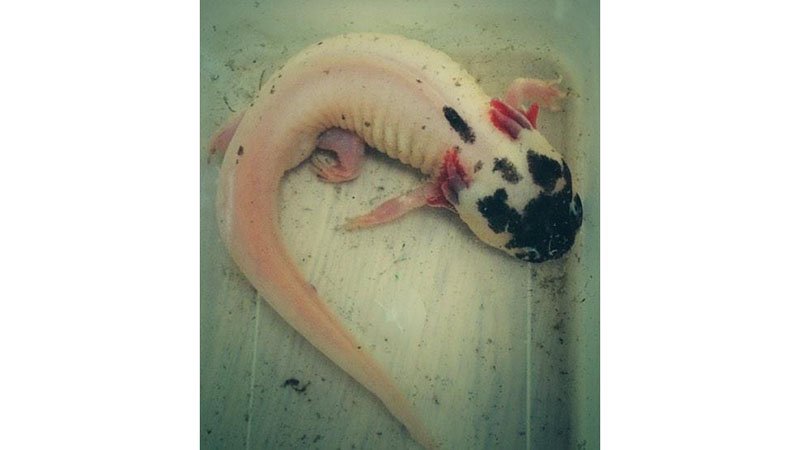
The Piebald Axolotl is a captivating variety that stands out with its unique pattern of pigmentation. This morph is characterized by its striking mix of large unpigmented patches, typically white or pink, interspersed with pigmented sections. These pigmented areas can vary in color, ranging from black and grey to golden, reflecting the axolotl’s underlying genetic makeup.
The distribution of pigmentation in Piebald Axolotls is random and unique to each individual, creating a distinct pattern where pale areas lacking melanin contrast sharply with the darker, pigmented sections. Unlike a leucistic axolotl, which typically has spots only along the head and back, a Piebald’s pigmentation often extends down the body and sides, making it visually striking and easily distinguishable.
Piebald Axolotls are not just visually stunning but also genetically unique. Unlike the Chimera and Mosaic varieties, which are results of genetic anomalies, Piebald is a genetically inheritable trait. This means that Piebald Axolotls can pass their distinct patterns to their offspring, making them a fascinating subject for breeding and genetics enthusiasts.
While heavily spotted leucistic axolotls are often mistaken for Piebalds, true Piebalds usually exhibit a darker and more dense pattern of black spots. In places like New Zealand, where Axolotls with Piebald genetics are somewhat common, distinguishing true Piebalds from ‘dirty-faced’ leucistics adds an intriguing aspect to the hobby of keeping and breeding these remarkable creatures.
Enigma Axolotl
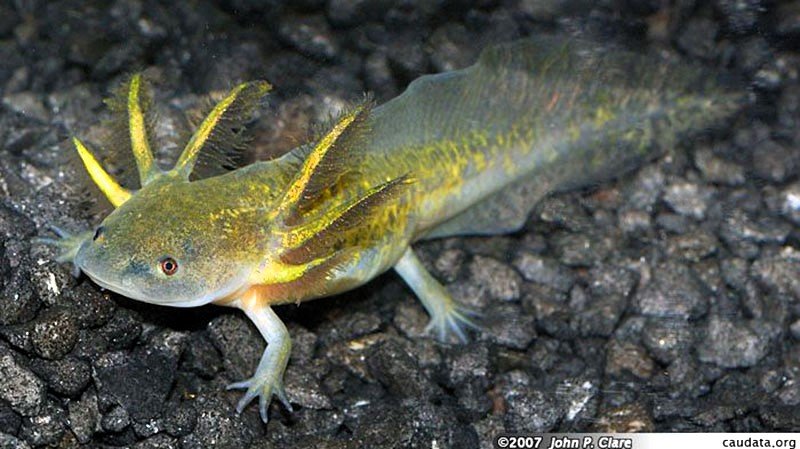
The Enigma Axolotl is a mesmerizing and unique variety of axolotl, celebrated for its diverse and unpredictable coloration. Unlike other axolotl morphs that typically exhibit more uniform colors, Enigmas presents a stunning array of colors, including black, white, gold, grey, and various other hues. Their bodies are adorned with an eclectic mix of patterns, such as spots, patches, stripes, or other unique markings.
The beauty of the Enigma Axolotl lies in its randomness; each individual displays a pattern that is entirely its own, making every Enigma Axolotl one-of-a-kind. The eyes of these axolotls often mirror the intriguing coloration of their skin or stand out with their distinct hue. Their gills, feathery and possibly multi-colored, further enhance their striking appearance, adding to the overall allure of this rare morph.
The Enigma Axolotl, known for its unparalleled beauty, is a rare gem in the Axolotl world, primarily bred and available within the United States. Little is known about this specific axolotl, which adds to its mystique.
Silver Dalmatian Axolotl

The Silver Dalmatian, also known as the Lavender Axolotl, is an enchanting morph that captures the heart with its delicate coloration and distinctive patterning. The primary hue of this morph is a gentle, silvery lavender, a serene shade that lends the axolotl its name.
This subtle yet captivating color results from a unique blend of genetic traits, creating a soft backdrop for the more dramatic aspects of its appearance. True to its “Dalmatian” moniker, this axolotl variety features dark spots or speckles reminiscent of the famous dog breed. These markings, varying in size and density, are usually black or dark gray, creating a striking contrast against the pale lavender body.
The eyes of a Silver Dalmatian are typically dark, further accentuating the contrast with their lighter body. The gills often match the body’s color, with feathery filaments that may have darker tips, adding an extra layer of visual interest against the axolotl’s pale skin. It’s believed that these axolotls are primarily available in the United States.
FireFly Axolotl
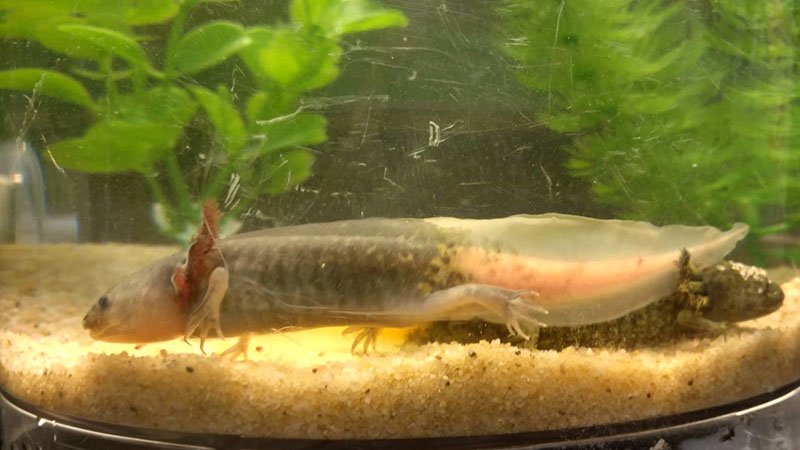
The FireFly Axolotl is a remarkable creation in the world of axolotls, a true one-of-a-kind marvel that first appeared in 2016 thanks to the ingenuity of Lloyd Strohl II from Indiana, USA. These axolotls aren’t the result of genetic modification but are crafted through embryonic grafting.
The FireFly Axolotl stands out with its stunning color contrast – typically sporting a dark or black head and upper body paired with a bright, fluorescent green tail. This vivid contrast is reminiscent of a firefly, which inspired its name. While the green portion mimics the look of bioluminescence, it doesn’t actually glow in the dark. This effect is usually achieved by incorporating GFP (Green Fluorescent Protein) genes similar to those found in GFP Axolotls.
Created as part of Lloyd Strohl II’s research into the distribution and activation of melanocytes in leucistic and mosaic axolotls, the FireFly Axolotl is not only a scientific curiosity but also a visual spectacle.
Blue Axolotl

As of my last update in April 2023, there is no such thing as a genetically Blue Axolotl. Sometimes, Axolotls are mistakenly thought to be blue due to certain lighting conditions or the coloration of their tank environment, but this is not a natural color for them. True blue Axolotls do not exist in nature or through breeding. Axolotls come in a variety of colors, including wild type, leucistic, albino, melanoid, and GFP, but blue is not among these natural color variations.
The misconception about blue Axolotls often stems from misleading images or descriptions, which might be due to lighting effects, photographic filters, or digital alterations. Axolotls’ color spectrum ranges from dark browns and blacks to whites, pinks, and golden hues, depending on their genetic makeup. If you come across a blue Axolotl, it’s likely the result of artificial factors or a misinterpretation of the creature’s actual color. When choosing an Axolotl, it’s important to be aware of these natural color variations and understand that while they are diverse and beautiful, blue is not a color you will naturally find in these fascinating creatures.
Caring for Different Types of Axolotls
While different axolotl types may have varying colors and patterns, their care requirements are largely the same. They need a cool, clean aquatic environment, with temperatures ideally maintained between 16-18°C (60-64°F). The water should be well-filtered, with a neutral pH. Axolotls are carnivorous and thrive on a diet of worms, small fish, and specialized amphibian pellets. It’s important to avoid overfeeding and to keep the tank clean to prevent fungal and bacterial infections.
Conclusion
Axolotls are unique pets and a testament to nature’s diversity and adaptability. From the common wild type to the rare copper and chimera morphs, these different types of axolotls bring their own charm and challenges. As fascinating as they are to own, it’s important to remember the responsibility that comes with caring for these extraordinary creatures.
If you are a fan of Mexican axolotls, you can design and customize some custom patches about your cute pets. Whether it is a unique body shape, a cute moment in life, or a record of various stages of growth. You can customize it into some patches, and turn the “flash of inspiration” of getting along with your pet into a tangible memory.

These delicate totems that will not fade will eventually become the most gentle footnotes in your breeding log – after all, we are all used to using the warmth of our hands to pay tribute to the magic of life.










